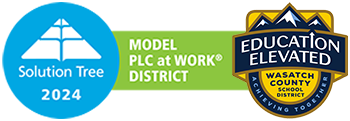Resources
Find Us
help@wasatch.edu
Contact
Technology Support Protocol
Our Technology Support Services professionals provide technical support for staff and students throughout the district. We provide this support with a Technology Support Specialists and a district-level service system that is web accessible that can help with support issues. If a problem cannot be solved in the building or by the technical staff, it can be taken to support personnel at the district technology office, where they work with our systems staff and our vendors to find a solution.
In Wasatch School District, we take pride in supporting a computing environment to best meet the needs of educating students. Below are some facts about the support we provide.
- Beginning in the 2011 school year, all instructional staff have district-provided laptops allowing them to better integrate technology into every lesson.
- We actively manage our desktop environments to allow remote technical support, as well as remote and on-demand installation and updating of software.
- We supervise technology asset management for the school district, helping to coordinate purchasing decisions, manage current inventory, and arrange for disposal of old computer technology in an environmentally friendly manner.
- We provide school district hardware and software standards, and we manage the deployment of new hardware and software systems.
How to get technology help
For school district staff members, the easiest way to get help with your computer is to open a ticket at HelpDesk “Jira” They will take the necessary steps in the process of finding a solution to your problem.
Internet Safety
This document is intended to provide parents with information regarding how Wasatch County School District (WCSD) is working to keep your student safe while on the Internet. This document includes WCSD three-tenant approach to Internet safety, Internet safety sites that can be reviewed by both students and parents, as well as other information that parents may find useful .
Student Safety:
The three- tenants of WCSD’s approach to keeping students safe while using computer technology:
- Accessible Use Policy. “All Internet or computer equipment use shall be consistent with the purposes, goals, and policies of the [WCSD]. It is imperative that users of the network or computer equipment conduct themselves in a responsible, ethical, moral, and polite manner. All participants must abide by all local, state, and federal laws. The Internet user accepts the responsibility of adhering to high standards of conduct and the terms and conditions set forth in all parts of this policy” (WCSD Student AUP).
- Student Supervision. Students are supervised by adult staff during online activities. This supervision encourages students to make wise choices. Teachers and Staff are asked to monitor student activity in their classrooms and other places at school. Parents are encouraged to supervise their student outside of school.
- District Internet Filter. WCSD uses and monitors a district wide Internet filter. The filter is in place for all student devices whether within district schools or outside. This filter also logs Internet activity for all students. As a district, we trust the filter and are confident in the protection it provides our students. With that said, WCSD cannot guarantee that all inappropriate content is blocked. Internet filters are based on web page addresses and text found on those web pages. Due to that limitation, images are difficult to filter out on sites such as Google Images. Thus, it is strongly encouraged that parents supervise their student while on the Internet at home. Students are expected to adhere to the Student AUP while online and away from school.
Internet Research: (http://pioneer.uen.org/k12/)
Internet Safety:
There can also be dangers associated with the internet if students do not follow the safety guidelines that have been outlined at school. We want parents to also be aware of these dangers and encourage their children to follows the same safety guidelines at home.
The state has provided the following websites to assist parents in understanding Internet safety, and to also help students understand why Internet Safety expectations are in place.
Safe Kids (http://www.safekids.com/)
Safe Kids is a resource with information about online safety & civility. It also includes a “Parents Guide to Facebook” which provides parents with the tools they need to help their teens optimize privacy and safety on Facebook.
Net Safe Utah (http://www.netsafeutah.org)
NetSafe Utah provides tools to help families communicate and have a safe online experience. This website is sponsored by the Utah Education Network, Utah Internet Crimes Against Children taskforce, along with many other sponsors listed on the home page.
NetSmartz Workshop (http://www.netsmartz.org)
The Netsmartz Workshop was developed by the National Center for Missing and Exploited Children and The Boys and Girls Clubs of America to teach children how to be safe when using the Internet. The goal of the NetSmartz Workshop is to extend the safety awareness of children to prevent victimization and increase self-confidence whenever they go online.
Additional Information for Parents:
We offer the following information for parent consideration:
• Between 90 – 95% of all AUP violations occurred at home during the 2013 – 14 school year.
• Some of these AUP violations occurred while a parent was 10 feet away from the student. The parent was simply unaware of their students internet activity.
• Time frame these AUP violations occurred:
– Before parents were home, 3:00 – 5:00 PM
– Late at night, 11:00 PM – 2:00 AM (Between 70 and 75% of the AUP violations occurred during this time frame).
– Early in the morning, 4:00 – 6:00 AM
Please consider this information as a way to help your student be safe at home and create expectations for computer use off school campus.
Please remember that parents are the best filter and security their children can have regarding Internet Safety.

